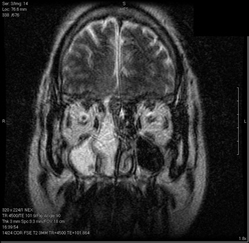Endoscopic CSF Leak Repair and Anterior Skull Base Surgery
Cerebrospinal fluid (CSF) leak
Extravasation of the fluid normally contained in the ventricles of the brain, the subarachnoid space and the central canal of the spinal cord through a hole in the lining of the brain or spinal cord (meninges). Within the realm of rhinology and endoscopic sinus surgery, CSF leak generally refers to watery, clear nasal drainage coming through a defect of the cranial base and meninges associated with the frontal, ethmoid or sphenoid sinuses. Likewise, a rhinologist-endoscopic sinus surgeon encounters meningoencephaloceles protruding through cranial defects in the frontal, ethmoid and sphenoid sinuses.
Meningoencephalocele
Protrusion of the brain and its lining (meninges) through a hole in the cranium.
Meningocele
Protrusion of the lining of the brain (meninges) and cerebrospinal fluid through a hole in the cranium.
Two decades ago, cerebrospinal fluid (CSF) leaks, meningoencephaloceles and skull base tumors involving the paranasal sinuses or nasal cavity were managed through external (scalp) incisions and craniotomies. The introduction of nasal endoscopes and specialized endoscopic sinus and skull base instrumentation allows resection or repair of many anterior skull base lesions through the nose. The endoscopic approach affords decreased patient discomfort, shorter hospitalization and in many cases, increased visualization for the surgeon during the procedure and during post-operative follow-up or surveillance. Treatment of these lesions via an endoscopic approach requires specialized training of the surgeon and operating room staff familiarity with dedicated endoscopic skull base instruments and computerized surgical navigation. Treatment often requires a team approach, utilizing the skills of a neurosurgeon and rhinologist-sinus surgeon. Additionally, endoscopic resection of skull base malignancies must be carefully considered in the setting of a multidisciplinary tumor board or team (medical oncologist, radiation oncologist, head and neck surgeon, endoscopic skull base surgeon, neurosurgeon). Generous tumor margins are generally not obtained with the endoscopic technique and this must be accounted for in the overall management of the patient’s disease. Furthermore, the endoscopic approach to anterior skull base tumors is a newer technique compared to the external craniofacial resection. This limits the longitudinal data we have allowing us to predict the prognosis of a patient undergoing endoscopic resection of a malignant tumor.
NOTICE: This information and video is not presented as advice or instruction. The video and content is for information purposes only and not to be considered instruction or medical advice. Should you have medical concerns, please consult with your physician directly. Read our disclaimer here.
Download Patient Post-Operative Instructions

